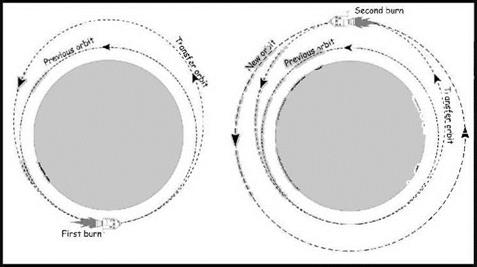Changing orbits
At this stage, having achieved an orbit, it is worth considering what a spacecraft does to change it. Our box of beads has no means of propulsion and once released into its orbit, it is doomed to revolve around our imaginary Earth to the end of time. Of course, real life isn’t like that. Spacecraft usually have some kind of rocket motor, especially human-carrying ships that must return to the home planet.
Imagine, then, that our box of beads is a spacecraft w’ith an engine. Let us assume that, having entered a circular orbit, we want to reach a higher orbit. To do so. we must increase our speed further by firing the engine, its nozzle aimed rearwards. This would straighten out the flight path a little and cause the spacecraft to enter an elliptical orbit in which it would coast to an apogee on the other side of the planet. The point at which the burn w’as made becomes a perigee, and if the duration of the burn is appropriately timed, the spacecraft can be made to ascend to any desired apogee altitude. Half an orbit later, having slowed down considerably (just like any object tossed upward in a gravity field), it arrives at apogee but does not have enough momentum to stay at that altitude and will fall back to its perigee as it continues around the planet. Apogee then becomes a good place to adjust the altitude of the orbit’s perigee. By adding yet more speed at apogee with another burn, the flight path is straightened out further, so that the spacecraft does not fall
|
Diagram showing how a spacecraft raises its orbit by a Hohmann transfer. |
quite so far as it descends to perigee. If enough extra speed is applied at apogee, the shape of the orbit can be made circular again, this time at the higher altitude. This method of transferring from one orbit to another involving a pair of burns perfonned 180 degrees apart is known as the Hohmann transfer orbit and was formulated in the early part of the twentieth century by Walter Hohmann, a member of the same German rocketry club as Wernher von Braun.
Now comes the counter-intuitive bit. Although our imaginary spacecraft’s speed had been increased on two occasions, it ended up travelling much more slowly than when it was in the lower orbit. Its speed had been traded for height, a situation that will be familiar to all fighter pilots. There are all sorts of ramifications to this in terms of spaceflight operations, especially for Apollo. For example, if one spacecraft wanted to catch up with another that was ahead in the same orbit, the wrong thing to do would be to aim towards the target, light the rockets and try to fly directly towards the quarry. This would make its orbit more elliptical, raise it to a higher apogee and it would therefore travel more slowly, thereby opening the range, which is exactly the opposite of the desired effect. The right thing to do would be to turn the craft around and fire to slow down, thereby making the orbit elliptical with a lower perigee. This increases the spacecraft’s speed and closes the range. Then, to effect a rendezvous the spacecraft would need to turn around yet again and make another burn to rise back up to the target’s orbit at just the right time.
Clearly, making large manoeuvres in space has to be done with careful forethought. Computers and radars are also indispensable tools. This was especially true during an Apollo flight where the success of the mission depended on the ability of two spacecraft to rendezvous successfully. It was also true from the point of view
of their next major manoeuvre; the burn to set them on a path to the Moon, itself essentially a Hohmann transfer.
Immediately after the Apollo/Saturn stack had achieved orbit, Earth-based radars began to track the vehicle to determine its trajectory as precisely as they could. From these measurements, computers at mission control calculated a suitable Moon – bound trajectory and the details of a burn that would achieve it. given the constraints of what the S-IVB could manage. These details were transmitted to the computer within the instrument unit. Whatever information was relevant to the crew was passed on to them also in the form of a list of numbers manually read up by the Capcom. Based on these calculations, and after a little more than 2’/2 hours orbiting Earth, the S-IVB stage reignited and set the Apollo spacecraft on its path to the Moon.











